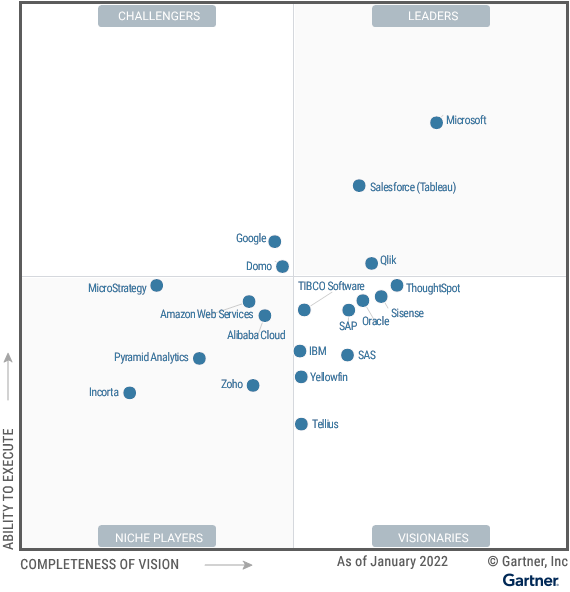Gartner Magic Quadrant for Analytics and Business Intelligence Platforms 2022
It’s that time of the year again: Gartner just published its holy Magic Quadrant for Analytics and Business Intelligence (ABI) Platforms for 2022! Our beloved SAP Analytics Cloud is SAP’s offering in this area and is compared to tools as PowerBI (Microsoft), Tableau (SalesForce) and Qlik.

Status Quo?
When I look at the sections in the report for these four players I’m surprised how little has changed since the 2021 quadrant. I could basically just repeat most of the comments that I wrote in last year’s blog here.
Microsoft is still the top leader with PowerBI, Tableau is a strong number 2 and even Qlik is still regarded as a “leader”. Besides the (obvious) ability to deliver a proper technical solution, PowerBI and Tableau already have a very high adoption and with their extremely rich and active user communities it is very unlikely that they will loose this position any time soon. On that topic, SAP lost focus on their (BOBJ) community a couple of years ago and has to build this back up. Fortunately, I do see that SAP is actually showing some very good progress on this and it is definitely going into the right direction again (I’m still not a fan of the community site in its current form though, but that’s another topic).
Visionaries
In the image gallery below you can compare the quadrant of 2022 with 2021. You can see that SAP is a bit on the move in the “visionaries” square.
- MQ 2021
- MQ 2022
Strengths
As mentioned, the specific comments for SAP Analytics Cloud are similar to those of the 2021 report. Strengths are in the “unmatched” SAP connectivity and integration with other SAP (cloud) solutions, the availability of business content, its augmented capabilities and “closed-loop” analytics (the integration of planning, analysis and prediction in a single solution, which is pretty unique). Maybe it is now time to double-down on the further integration/bundling with Data Warehouse Cloud (DWC) to offer more easy data modeling capabilities and close the gap to for example a PowerBI, which already offers this within the tool itself.
For years now Gartner is assigning a lot of value to augmented features (it is mentioned almost 50 times in the report), which basically cover things like automated insights, natural language processing (NLP), generation (NLG) and understanding (NLU). I understand this is something that in potential could get big very quickly in the future, but for now I’m not blown away by it. From what I’ve seen and tried in SAP Analytics Cloud you still require a very clean (data) setup to get some results that make sense and provide some actual value. I read in the section on Oracle that they even have an automated data storytelling feature in their tool that is capable of generating podcasts on key trends, data changes, outliers and all sorts of other insights. Sounds cool if this actually works!
Cautions
Cautions for SAP Analytics Cloud are in its lower market momentum and limited/non-existing adoption outside of the SAP bubble. Sure, connectivity to non-SAP sources is still difficult; live connectivity to SQL-sources is for example still very far away (still in the future direction of the roadmap; >2023). Data modeling is extremely limited and the available blending features are difficult to use. Again, DWC would be a logical stepping stone here to solve a lot of these problems and make SAP Analytics Cloud more attractive to smaller (and non-SAP) customers without large IT departments and BW or HANA data warehouses.
For some reason Gartner also still regards the cloud-only deployment of SAP Analytics Cloud as a risk. I really thought that this was a discussion from the past but apparently it’s not. My concern on this would rather be that SAP Analytics Cloud stil doesn’t cover a set of core features of the on-premise SAP BusinessObjects (BOBJ) Platform, for example the scheduling of Excel files and the repository for Analysis Office workbooks. This could lead to huge issues when companies want to move away from BOBJ and start looking for successors that can at least offer the same baseline functionality.
No Surprises
So yeah, not really any surprises in this report. For the coming years I really hope to see a much tighter integration/bundling with Data Warehouse Cloud, as this could finally give us the (self-service) toolset to workaround some of the inflexibilities of SAP Analytics Cloud. But, I don’t expect to see any major changes to the Magic Quadrant for the near future.


